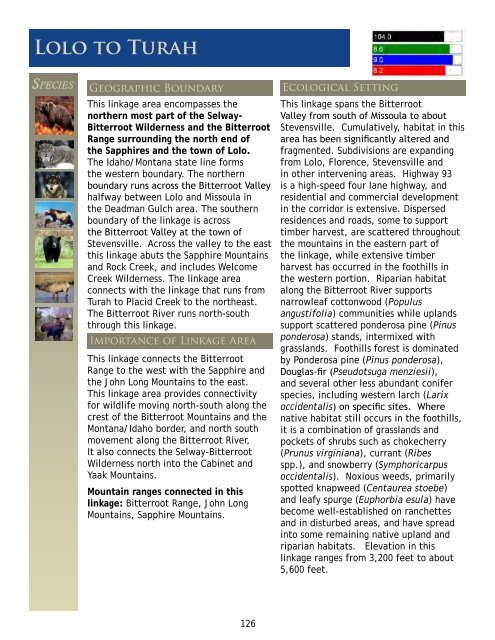The Hub Conservation Area - Montanans 4 Safe Wildlife Passage
The Hub Conservation Area - Montanans 4 Safe Wildlife Passage
The Hub Conservation Area - Montanans 4 Safe Wildlife Passage
Create successful ePaper yourself
Turn your PDF publications into a flip-book with our unique Google optimized e-Paper software.
Lolo to TurahSpeciesGeographic BoundaryThis linkage area encompasses thenorthern most part of the Selway-Bitterroot Wilderness and the BitterrootRange surrounding the north end ofthe Sapphires and the town of Lolo.<strong>The</strong> Idaho/Montana state line formsthe western boundary. <strong>The</strong> northernboundary runs across the Bitterroot Valleyhalfway between Lolo and Missoula inthe Deadman Gulch area. <strong>The</strong> southernboundary of the linkage is acrossthe Bitterroot Valley at the town ofStevensville. Across the valley to the eastthis linkage abuts the Sapphire Mountainsand Rock Creek, and includes WelcomeCreek Wilderness. <strong>The</strong> linkage areaconnects with the linkage that runs fromTurah to Placid Creek to the northeast.<strong>The</strong> Bitterroot River runs north-souththrough this linkage.Importance of Linkage <strong>Area</strong>This linkage connects the BitterrootRange to the west with the Sapphire andthe John Long Mountains to the east.This linkage area provides connectivityfor wildlife moving north-south along thecrest of the Bitterroot Mountains and theMontana/Idaho border, and north southmovement along the Bitterroot River,It also connects the Selway-BitterrootWilderness north into the Cabinet andYaak Mountains.Mountain ranges connected in thislinkage: Bitterroot Range, John LongMountains, Sapphire Mountains.Ecological SettingThis linkage spans the BitterrootValley from south of Missoula to aboutStevensville. Cumulatively, habitat in thisarea has been significantly altered andfragmented. Subdivisions are expandingfrom Lolo, Florence, Stevensville andin other intervening areas. Highway 93is a high-speed four lane highway, andresidential and commercial developmentin the corridor is extensive. Dispersedresidences and roads, some to supporttimber harvest, are scattered throughoutthe mountains in the eastern part ofthe linkage, while extensive timberharvest has occurred in the foothills inthe western portion. Riparian habitatalong the Bitterroot River supportsnarrowleaf cottonwood (Populusangustifolia) communities while uplandssupport scattered ponderosa pine (Pinusponderosa) stands, intermixed withgrasslands. Foothills forest is dominatedby Ponderosa pine (Pinus ponderosa),Douglas-fir (Pseudotsuga menziesii),and several other less abundant coniferspecies, including western larch (Larixoccidentalis) on specific sites. Wherenative habitat still occurs in the foothills,it is a combination of grasslands andpockets of shrubs such as chokecherry(Prunus virginiana), currant (Ribesspp.), and snowberry (Symphoricarpusoccidentalis). Noxious weeds, primarilyspotted knapweed (Centaurea stoebe)and leafy spurge (Euphorbia esula) havebecome well-established on ranchettesand in disturbed areas, and have spreadinto some remaining native upland andriparian habitats. Elevation in thislinkage ranges from 3,200 feet to about5,600 feet.126




